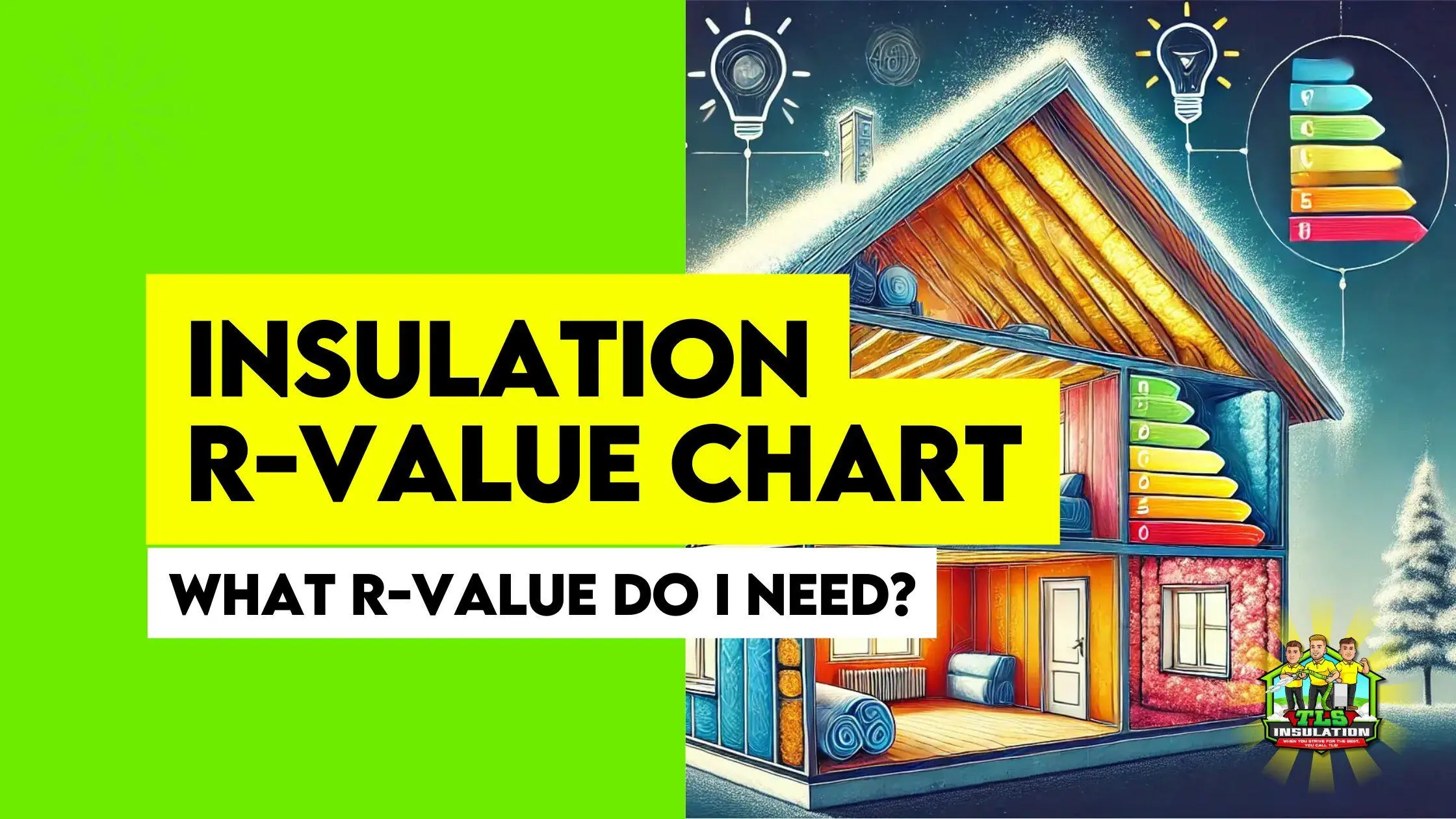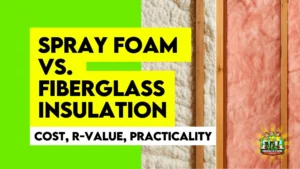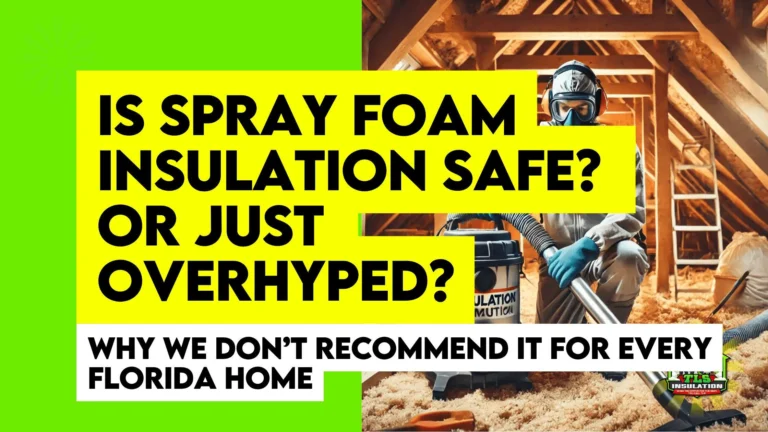Selecting the right insulation for your home is more than just picking a random R-value from an insulation r-value chart or referencing an insulation thickness chart.
The math about Insulation R-value is definitely not straightforward.
Factually, real-world variables like IECC zones, local climate extremes, building design, and the specifics of your wall or attic construction affect final energy costs and comfort.
For example, For colder IECC zones, higher R-values and thicker insulation can curb heat losses in winter, while milder regions may do well with slightly lower ratings. Additionally, it’s wise to match your insulation material to local climate demands.
The goal is to balance cost and performance: the correct thickness not only locks in comfort but also ensures each dollar spent on heating and cooling stretches further. So, by prioritizing these practical considerations, homeowners can achieve year-round energy savings without overextending their budgets.
What is R-value and How Do We Calculate It?
R-values measure thermal resistance, dictating how effectively an insulation material restricts heat flow in various climates. The higher the R-value, the more potential you have to cut down on heating and cooling expenses.
However, if you ask us an one-liner definition of R-value, here it’s the simpler one;
R-value measures how effectively an insulation material slows heat flow.
- Higher R-value = better thermal resistance
- Lower R-value = weaker insulation
We calculate it by dividing the temperature difference by the heat transfer rate. Consulting an insulation r value chart or insulation thickness chart then helps pinpoint the optimal level for your specific project.
Here is the technical equation;
R-value = ΔT / Q,
ΔT is the temperature difference and Q is heat transfer.
How Much Insulation Do I Need – Know Through Insulation R-Value Chart
One notable study from the National Renewable Energy Laboratory underscores how IECC zones can shift recommended attic insulation thickness from around 6–9 inches in Zones 1-2 achieving R-30 to R-38 to 15+ inches in Zones 7–8, hitting R-60 or higher.
These variations aren’t mere code formalities; they address real-world issues like thermal bridging, moisture control, and energy savings. By aligning thickness with local conditions, homeowners and builders move beyond one-size-fits-all insulation strategies toward genuinely optimized comfort and cost-effectiveness.
| R-Value | IECC Zones | Approx. Thickness | Recommended Usage | Common Materials | Key Remarks |
|---|---|---|---|---|---|
| R-13 | Zones 1–2 | ~3–4 inches | Basic wall insulation for mild climates | Fiberglass Batts, Foam Board Insulation, Cellulose | Minimal coverage to slow heat flow in warmer regions; an entry-level standard in some locales. |
| R-19 | Zones 2–4 | ~5–6 inches | Floors above unconditioned spaces, warmer walls | Fiberglass, Cellulose Insulation, Blown-In | Moderately boosts thermal resistance, balancing cost with energy savings. |
| R-30 | Zones 3–5 | ~8–9 inches | Attic floors, vaulted ceilings, colder floors | Fiberglass, Blown-In, Foam Board | Popular sweet spot for mixed-climate homes; effective at cutting heating and cooling loads. |
| R-38 | Zones 4–6 | ~10–12 inches | Primary attic insulation, deeper walls | High-Density Fiberglass, Closed-Cell Foam | Ideal for regions with notable winters; significantly curtails heat losses. |
| R-49 | Zones 5–7 | ~14–15 inches | Colder attics, upper floors | Dense-Pack Cellulose, Foam Board Insulation | Meets tougher insulation ratings for sub-freezing temperatures; cuts annual heating bill. |
| R-60+ | Zones 6–8 | 16 inches or more | Extreme cold or sub-zero climates | Spray Foam Insulation, High-Density Fiberglass | Suited for severe environments; substantially lowers heat losses and keeps interiors stable. |
R-13 to R-19
- Ideal for warmer IECC zones where heat losses are moderate.
- Common in standard 2×4 wall assemblies, garage insulation, or floors over unheated spaces.
- Properly installed fiberglass or foam board can maintain insulation performance when sealed against air leakage.
R-19 to R-30
- Serves mixed climates demanding moderate insulation r values to handle both heating and cooling loads.
- Often used in 2×6 walls, crawlspace wall insulation, and lower-depth attic insulation.
- Balancing insulation thickness with cost ensures good energy savings without overkill.
R-30 to R-38
- A sweet spot for colder mid-range zones, offering enhanced thermal resistance in attics or vaulted ceilings.
- Helps combat extreme heat swings when combined with air-sealing to reduce heat flow.
- Closed-cell foam insulation r-value can reach this range with minimal thickness, excellent for tight spaces.
R-38 to R-49
- Designed for colder IECC regions, substantially reducing annual heating bill through stronger insulation ratings.
- Ideal for ceiling insulation or higher-performing exterior walls, especially in climates with harsh winters.
- Layering different insulation materials (e.g., foam board + batt insulation) can mitigate thermal bridging.
R-49 to R-60+
- Essential in sub-zero or mountainous climates where inadequate insulation results in significant heat losses.
- Often achieved through multiple layers of spray foam insulation or thick fiberglass/cellulose to meet the high r-value demand.
- Sealing and maintaining dryness are crucial, as moisture can degrade even top-tier r-values over time.
Factors Influencing Insulation R-values and Thickness
According to a National Renewable Energy Laboratory study, subtle climate differences can significantly shift recommended insulation r values, underscoring the importance of careful evaluation before selecting any insulation material.
- Material Composition:
The base insulation r value per inch varies by material (e.g., fiberglass, foam, cellulose). High-density options often deliver higher R-values but may increase cost and complexity during installation. - Insulation Thickness:
While adding more layers generally boosts insulation r values, an excessive buildup can lead to diminishing returns if it surpasses IECC code requirements for your region or building type. - Thermal Bridging:
Structural elements like studs and joists can create direct paths for heat flow, effectively lowering the insulation’s measured R-value by bypassing the surrounding insulating layers. - Moisture & Installation Quality:
Inadequate sealing or exposure to high humidity can degrade insulation performance. Even premium materials under-perform if improperly installed, leading to increased heat losses over time. - Regional Climate (IECC Zones):
Colder IECC zones typically demand higher insulation r values to counteract severe winter conditions. Conversely, milder climates can achieve efficiency with moderately rated insulation, as long as moisture management is addressed.
Regional Climate Affecting Insulation R-values
IECC zones significantly affect recommended insulation r-values, as each region follows distinct insulation thickness chart guidelines to manage extreme heat or cold. Zones 6–8 typically require higher insulation r value per inch to combat intense heat losses, while Zones 2–3 can use moderate r-values. Selecting the right insulation material for each zone ensures maximum energy efficiency and occupant comfort.
| IECC Zone | Major States | Typical R-Value Range | Average Thickness | Recommended Materials |
|---|---|---|---|---|
| 1–2 | FL, HI, Southern TX, PR | R-13 to R-21 | 3–5 inches | Fiberglass, Cellulose |
| 3–4 | Southeastern US, Mid-Atlantic, Southern CA | R-19 to R-30 | 5–8 inches | Fiberglass, Cellulose, Spray Foam |
| 5–6 | Midwest, Northeast, Northern CA | R-30 to R-38 | 8–12 inches | Foam Insulation, Cellulose Insulation, Fiberglass |
| 7–8 | Northern States, Alaska | R-38 to R-49 | 12–18 inches | High-Density Fiberglass, Foam Board Insulation |
Note: Values may vary based on local building codes and specific design requirements. Always consult an insulation r-value chart or professional guidance for precise recommendations.
What R Value Do I Need When Choosing Insulation Material:
Choosing the right insulation material directly impacts insulation r-values, energy savings, and overall heating and cooling performance. Whether you’re insulating walls, attics, or ceilings, it’s crucial to balance insulation thickness, local IECC zones demands, and specific building conditions. Below is a concise reference table, followed by technical highlights for each material.
| Material | Typical R-Value | Thickness Range | Key Insights |
|---|---|---|---|
| Fiberglass Batt | R-2.9 to R-3.8 per inch | 3–10 inches | A blanket insulation often used in attic insulation and wall insulation. Effective for achieving R-30 or R-38 in many structures. Careful installation is vital: gaps, compression, or thermal bridging can lower the stated insulation r-value. |
| Blown-In (Loose-Fill) | R-2.2 to R-3.8 per inch | 4–12 inches | Common in old insulation upgrades or additional insulation projects. Ideal for filling irregular cavities in ceiling insulation or garage insulation. Settlement over time may affect r-values, so proper density and consistent coverage ensure stable performance. |
| Cellulose Insulation | R-3.2 to R-3.8 per inch | 5–12 inches | Derived from recycled paper, it’s great for wall insulation or attic insulation r-value improvements. Dense packing mitigates leakage, boosts insulation performance, and helps reduce heat losses. However, exposure to moisture can degrade overall r-values. |
| Foam Board Insulation | R-4.0 to R-6.5+ per inch | 1–4 inches | A rigid board insulation solution—often used for crawlspace wall insulation, foundation exteriors, or under roofing materials. Minimizes thermal bridging and can achieve r-values like R-25 or R-49 with layering. Excellent for preventing heat transfer and moisture intrusion. |
- Fiberglass Batt (Blanket Insulation)
Generally used with layer thicknesses meeting r-value insulation chart targets (e.g., r-30, r-38). If properly insulated with minimal compression, it delivers reliable thermal resistance for heating and cooling efficiency. However, inadequate insulation or thermal bridging can diminish its overall r-value. - Blown-In (Loose-Fill) Insulation
Offers flexibility in filling odd-shaped spaces, improving insulation ratings in attics and walls. Often chosen for energy savings upgrades in old insulation retrofits. It’s crucial to maintain consistent density, as settling can reduce r-value rating over time. - Cellulose Insulation
A cost-effective, eco-friendly choice with high insulation r-values. Ideal for achieving high r-value layering in walls or attics. Resistant to air leakage when dense-packed, but prolonged exposure to moisture risks lowering its r-value and encouraging mold growth. - Foam Board Insulation
Delivers some of the highest r-values rate per inch, making it suitable for areas needing high r-values (e.g., r-49, r-60). Foam insulation r-value depends on type (EPS, XPS, polyiso). It’s excellent for minimizing heat flow through foundations, walls, and roofing assemblies, thereby cutting down cooling costs and annual heating bill.
Areas Requiring Specific R-values
Different parts of the home, especially the attic, floor, and ceiling have distinct insulation r values requirements for optimal performance.
We have listed down the important information in the form of tables, outlining recommended r-value insulation ranges, insulation thickness, and typical materials to consider for each area, based on various IECC zones and practical building standards.
| Material | Typical R-Value | Thickness Range | Key Insights |
|---|---|---|---|
| Fiberglass Batt | R-2.9 to R-3.8 per inch | 3–10 inches | A blanket insulation often used in attic insulation and wall insulation. Effective for achieving R-30 or R-38 in many structures. Careful installation is vital: gaps, compression, or thermal bridging can lower the stated insulation r-value. |
| Blown-In (Loose-Fill) | R-2.2 to R-3.8 per inch | 4–12 inches | Common in old insulation upgrades or additional insulation projects. Ideal for filling irregular cavities in ceiling insulation or garage insulation. Settlement over time may affect r-values, so proper density and consistent coverage ensure stable performance. |
| Cellulose Insulation | R-3.2 to R-3.8 per inch | 5–12 inches | Derived from recycled paper, it’s great for wall insulation or attic insulation r-value improvements. Dense packing mitigates leakage, boosts insulation performance, and helps reduce heat losses. However, exposure to moisture can degrade overall r-values. |
| Foam Board Insulation | R-4.0 to R-6.5+ per inch | 1–4 inches | A rigid board insulation solution—often used for crawlspace wall insulation, foundation exteriors, or under roofing materials. Minimizes thermal bridging and can achieve r-values like R-25 or R-49 with layering. Excellent for preventing heat transfer and moisture intrusion. |
| Floor Factor | Recommended R-Value | Typical Thickness | Common Materials | Practicality |
|---|---|---|---|---|
| IECC Zone 1–2 (Warm Climates) | R-13 to R-19 | 3–6 inches | Fiberglass, Cellulose Insulation | Minimizes heat losses through floors over crawl spaces; suitable for moderate temps. |
| IECC Zone 3–4 (Mixed Climates) | R-19 to R-25 | 6–8 inches | Fiberglass, Blown-In | Boosts insulation levels to handle varied weather and maintain comfortable floors. |
| IECC Zone 5–6 (Cool Climates) | R-25 to R-30 | 8–10 inches | Foam Board, Dense-Pack Cellulose | Higher r-values help retain warmth and reduce heating loads. |
| IECC Zone 7–8 (Cold Climates) | R-30+ | 10 inches or more | High-Density Foam Boards | Essential for harsh winters; prevents heat losses through flooring surfaces. |
| Ceiling Factor | Recommended R-Value | Typical Thickness | Common Materials | Practicality |
|---|---|---|---|---|
| IECC Zone 1–2 | R-19 to R-30 | 6–9 inches | Fiberglass Batt, Blanket Insulation | Suitable for low cooling demands; still mitigates heat flow upward. |
| IECC Zone 3–4 | R-30 to R-38 | 9–12 inches | Fiberglass, Spray Foam Insulation | Meets moderate heating needs; helps stabilize indoor temperatures. |
| IECC Zone 5–6 | R-38 to R-49 | 12–15 inches | Foam Insulation, Cellulose | Controls more extreme heat losses; often paired with sealed air barriers. |
| IECC Zone 7–8 | R-49+ | 15 inches or more | High-Density Fiberglass, Foam Boards | Critical for maximum energy savings in regions with prolonged cold spells. |
Frequently Asked Questions (FAQs):
What Is an Insulation R Value Chart?
An insulation r value chart compares materials and thicknesses to help you select the right R-value for specific climate zones and building needs.
How Does Insulation Thickness Chart Aid Energy Savings?
An insulation thickness chart shows exact depths required to achieve optimal insulation r-values, reducing heat losses and cutting down on long-term energy costs.
Which Insulation Material Offers the Highest R-Value?
Closed-cell foam insulation generally provides the highest insulation r value per inch, making it ideal for extreme climates and tight spaces.
Can I Exceed Code-Minimum R-Values for Better Efficiency?
Yes, going beyond the code-recommended r-values can enhance comfort and energy savings, but ensure proper installation to avoid diminishing returns.
Does Climate Affect My Insulation R-Value Selection?
Absolutely—IECC zones with colder temperatures need higher insulation r-values, whereas milder regions can use moderate ratings for cost-effective results.










